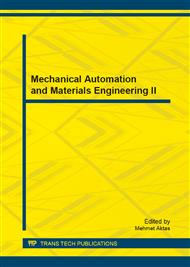p.32
p.36
p.41
p.45
p.49
p.57
p.62
p.71
p.79
Influence of the Type of Cement on the Formation of Calcium Carbonate Polymorphs due to Carbonation of Cement Materials
Abstract:
The objective of this study was to examine the influence of the type of cement on the formation of calcium carbonate CaCO3 polymorphs after carbonation of cement materials. Thermogravimetric analysis and X-ray diffraction were used to follow mineralogical changes of CEM I and CEM II mortars and pastes which were submitted to an accelerated carbonation at 20% CO2, 20°C and 65% relative humidity. The results indicated that aragonite and vaterite are formed from the carbonation of CEM II materials while these metastable polymorphs are not present in carbonated CEM I materials. It is likely that aragonite and vaterite are formed only at an advanced level of carbonation when pH is smaller than 9, which is the case of CEM I mortar and paste.
Info:
Periodical:
Pages:
49-53
Citation:
Online since:
June 2014
Authors:
Price:
Сopyright:
© 2014 Trans Tech Publications Ltd. All Rights Reserved
Share:
Citation:


